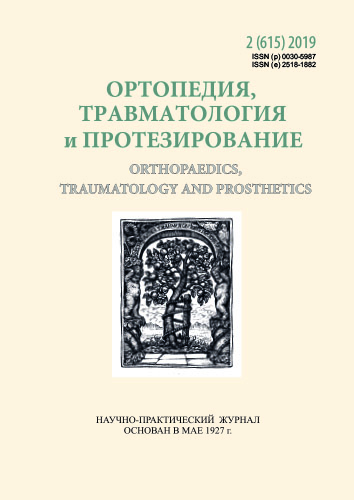Method of revealing indications for surgical treatment of posttraumatic extension contractions of the knee joint
DOI:
https://doi.org/10.15674/0030-59872019293-96Keywords:
knee joint, contracture, diagnosis, symptomAbstract
The diagnosis of «persistent extensor contracture of the knee joint» is established only when it is impossible to eliminate conservatively for a certain time.
Objective: to find a method of diagnostics of persistent post-traumatic extensor contractures of the knee joint, which hads to surgical treatment.
Methods: 23 people were examined with persistent extensor contractures of the knee joint that developed fractures of the femur. Complications were determined in all patients: delayed consolidation or nonunion of bone fragments, osteomyelitis, defects. The range of motion in the knee joint was 0°/0°/10°–15°. It has been established that for some, when the knee joint was bent, the movement ended smoothly, while for others, it was abrupt, with a sonic blow, as an obstacle. This phenomenon was investigated using a developed device consisting of a sound-receiving headset and a recording smartphone with the «Sound Oscilloscope » program.
Results: in 14 patients without a «symptom of hitting an obstacle» the range of movements in the knee joint reached normal values within 3–4 months of rehabilitation treatment. In 9 patients with a «symptom of hitting the obstacle», conservative treatment of knee joint contracture proved ineffective. These patients were diagnosed with «persistent extensor contracture of the knee joint» and surgical intervention was performed, after which the mobility in the joint was restored. We have proposed a method for determining the need for surgical treatment with persistent extensor contractures of the knee joint (patent № 132107 UA), which describes the «symptom of hitting an obstacle».
Conclusions: the method of determining the need for surgical treatment of persistent extensor contractures of the knee joint, as well as the «symptom of hitting the obstacle» is a diagnostic sign that indicates with a high degree of probability that the patient has the specified pathology. In these patients, it is necessary to immediately perform surgical treatment, without wasting time on a long-term ineffective and costly rehabilitation therapy.
References
- Bukup, K. (2008). Clinical study of bones, joints and muscles. Moscow: Medical literature. (in Russian)
- Vodyanov, N. M., Fokin, A. V., Avdonchenko, T. S., Robina, S. I., & Dovbeta, I. I. [and others] (2007). Restoration of the function of the knee joint with its contractures with the use of painkillers. Medical rehabilitation, 2 (8), 21–25. (in Russian)
- Ippolitov, I. Y. Brovkin, V. V., & Kistkin, A. I. (2006). Prevention and treatment of post-traumatic contractures of the knee joint. Herald of the University of Mordovia, 2, 186–188. (in Russian)
- Krasnov, A. F., Kotelnikov, G. P., & Chernov, A. P. (1999). Tendon-muscular plastics in traumatology and orthopedics. Samara: Samar. House. Seals. (in Russian)
- Marks, V. O. (1978). Orthopedic diagnostics. Minsk: Science and technology. (in Russian)
- Khabirov, F. A., Galyamov, D. L., Khabibrakhmanov, I. I., & Butenko, M. V. (1993). Postisometric relaxation and reflexotherapy in the treatment of posttraumatic contracture. Kazan Medical Journal, 2, 127–129. (in Russian)
- Bellemans, J., Steenwerckx, A., Brabants, K., Victor, J., Lammens, J., & Fabry, G. (1996). The Judet quadricepsplasty: a retrospective analysis of 16 cases. The Acta Orthopaedica Belgica, 62 (2), 79–82.
- Magee, D. J. (2014). Orthopedic Physical Assessment — E-Book. St. Louis, MO: Elsevier Health Sciences.
- Mass, A., Biasibetti, A., Demangos, J., Dutto, E., Pazzano, S., & Gallinaro, P. (2006). The Judet quadricepsplasty: long-term outcome of 21 cases. The Journal of Trauma: Injury, Infection, and Critical Care, 61 (2), 358–362. doi: 10.1097/01.ta.0000230281.31144.1d
- Pujol, N., Boisrenoult, P., & Beaufils, P. (2015). Post-traumatic knee stiffness: Surgical techniques. Orthopaedics & Traumatology: Surgery & Research, 101 (1), S179–S186. doi: 10.1016/j.otsr.2014.06.026
- Rose, R. (2005). Judet quadricepsplasty for extension contracture of the knee. West Indian Medical Journal, 54 (4). doi: 10.1590/s0043-31442005000400006
Downloads
How to Cite
Issue
Section
License
Copyright (c) 2019 Alexandr Barkov, Aleksandr Barkov

This work is licensed under a Creative Commons Attribution 4.0 International License.
The authors retain the right of authorship of their manuscript and pass the journal the right of the first publication of this article, which automatically become available from the date of publication under the terms of Creative Commons Attribution License, which allows others to freely distribute the published manuscript with mandatory linking to authors of the original research and the first publication of this one in this journal.
Authors have the right to enter into a separate supplemental agreement on the additional non-exclusive distribution of manuscript in the form in which it was published by the journal (i.e. to put work in electronic storage of an institution or publish as a part of the book) while maintaining the reference to the first publication of the manuscript in this journal.
The editorial policy of the journal allows authors and encourages manuscript accommodation online (i.e. in storage of an institution or on the personal websites) as before submission of the manuscript to the editorial office, and during its editorial processing because it contributes to productive scientific discussion and positively affects the efficiency and dynamics of the published manuscript citation (see The Effect of Open Access).














